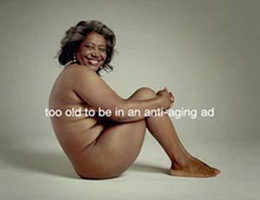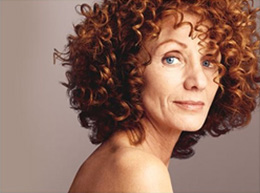A Contemporary Discourse of Western Beauty Ideals
Television Advertising
 |
|
The advertising medium of television is another key strategy of
Dove's ProAge marketing campaign. However, the commercial that
was designed for this line of products is currently banned from airing
on American television. The FDA ruled that the ProAge commercial
contained material that was too racy and explicit in nudity, deeming it
aesthetically inappropriate for general viewing audiences.
Psychoanalysis is mode of analysis that is often applied to the visual
materials of film and television. The tools of psychoanalysis can be
used to explore the discourse of the ProAge campaign, by studying the
content of this material with an emphasized concern for audience
relations. While watching this commercial, the observers are assumed to
react with varying levels of subjectivity and unconscious reaction. The
untamable nature of the mind's unconscious renders viewers incapable of
ever exhibiting complete subjectivity toward the subject matter. In
Dove's ProAge commercial, mainstream values concerning the
physical female image manifest in areas of the mind's unconscious,
altering how the ad is perceived by viewers. Using the analytic tools of
semiotics and the first kind of discourse, we have already addressed how
the ProAge campaign uses print ads to transcend hegemonic beauty ideals.
Now the methods of psychoanalysis indicate how ProAge uses the
advertising medium of television to create an imbalance in the hegemonic
structures of gender relations.
According to Mulvey, gender is a relational concept that asserts visions of femininity based on visions of masculinity. This ProAge commercial features various stills of everyday women who are over the age of fifty, posing naked in front of the camera. Although there are no "explicit" body parts shown, the women are still physically exposed and seemingly vulnerable to male viewers, in particular. Mulvey describes the masculine practice of observing from a distance, as voyeurism. This active way of seeing is marked not only by distance, but also by its tendency to objectify the female subject. However, voyeuristic male audience members are interrupted in this case, because the female subjects are well aware of the fact that they are being watched. Male viewers who are prone to habits of fetishistic scopophilia also seek to identify their subjects, but do so simply by observing the female figure as a beautiful object for display. This technique is also ineffective while watching Dove's ProAge commercial, because the female figures do not meet the masculine standards of feminine beauty. Although these women are all nude, they do not convey the culturally common messages of eroticism that often coincide with such representations of the female body. Mulvey states that in viewing processes, the determining "male gaze" projects its fantasy onto the female figure, which is then styled accordingly. However, this television ad defies masculine processes of viewing by shifting the viewing power into a position that allows women to create their own female identity. |
|
After the series of stills containing nude female figures
with the phrase "too old to be in an anti-aging ad", the commercial ends
with an empty screen that simply states "but this isn't anti-age, this
is pro-age." The very last still includes the text "new dove - beauty
has no age limit." This image is accentuated by the fact that it is read
aloud in a soothing female voice. The textual images included in this
advertisement are nearly identical to those found in the previously
examined print ads. There is a definite continuity across both marketing
mediums that re-iterates Dove's constructed ideologies of ageless
beauty. Perhaps the underlying reasons for the ban of this commercial are not so much concerned with the physically provocative figures, but rather with the threat that these images might impose on the dominant power of male audiences. Although this commercial is prohibited from airing on U.S. television, it is readily available on the Internet. In fact, the media-hype surrounding the ban itself has generated interest from a wide-range of cyber audiences. Although the ProAge campaign primarily targets "mature adult-female" audiences, the advertising medium of television and the incidental medium of the Internet have served as great platforms for reaching new audiences. The tools of psychoanalysis have demonstrated how this commercial works to empower females by defying masculine standards of beauty in a new discourse of femininity. |
|
  |
BACK HOME NEXT